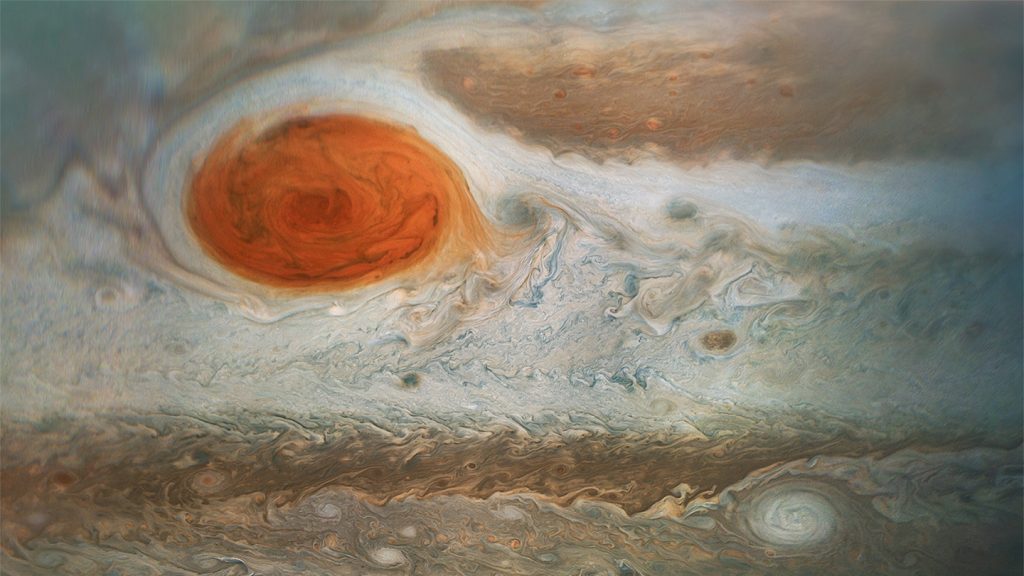Summarize this content to 2000 words in 6 paragraphs
Take our AI Survey
Science News has partnered with Trusting News to gather feedback on the potential use of AI in journalism. Currently, we do not publish any content produced by generative AI (see our policy). We do want to hear your views on how Science News could use AI responsibly. Let us know by participating in a short 10 question survey.
The Great Red Spot is our solar system’s largest vortex (SN: 12/12/17). Located in Jupiter’s Southern Hemisphere, the windstorm’s gusts exceed 600 kilometers per hour. But it’s not clear how far back in time this spot goes and what got it spinning.
Luckily, some planet observers of the past sketched what they saw through their telescopes. “It was very exciting to see in old articles and books the descriptions of the observations and drawings that astronomers made with great precision,” says Agustín Sánchez‐Lavega, an astronomer and planetary scientist at the University of the Basque Country in Bilbao, Spain.
Sánchez‐Lavega and his colleagues dug through records on the spots. Starting in 1713, reports of Jupiter bear no signs of the Permanent Spot. Then, in 1831 and the following decades, drawings show a spot resembling the Great Red Spot — a clear oval that became red-tinted.
Jupiter through the years
Box caption: For centuries, astronomers have observed Jupiter and its features. In the late 1600s and early 1700s, astronomer Giovanni Domenico Cassini and others observed a dark oval that became known as the Permanent Spot. But starting in 1713, reports of Jupiter lacked signs of that spot. Then, in 1831, sketches of the gas giant showed a feature at the same latitude — the Great Red Spot. Researchers today have sifted through the old images, some shown below, concluding that the spots are distinct.
Astronomer Giovanni Cassini drew this image of Jupiter, which shows the Permanent Spot, in July 1677. G.D. Cassini
This 1711 painting by Donato Creti depicts Jupiter in the night sky. The Permanent Spot is tinted red, perhaps because of a tip-off from astronomers who observed the planet. Donato Creti, courtesy Vatican Museums
About 20 years after it first appears in drawings of Jupiter, this sketch from May 1851 shows the Great Red Spot as a large oval (outer edge traced in a dotted red line). S. Swabe. Acknowledgements: ©UPV-EHU/UPC
In the first photo of Jupiter, taken in 1879, the Great Red Spot appears as a large dark ellipse. A.A. Common. Acknowledgements: ©UPV-EHU/UPC
In this drawing from November 1881, the Great Red Spot is fringed by a clear oval. This whitish area, still visible surrounding the Great Red Spot, is called the hollow. T.G. Elger
In this photo of Jupiter taken in 1890 at the Lick Observatory in California, the color-enhanced Great Red Spot is larger than it is today. Lick Observatory. Acknowledgements: BDIP-Observatoire Paris
Measurements of the Permanent Spot from drawings suggest that it was about one-third to one-half as wide as the Great Red Spot as photographed in 1879, which at the time was about three times the width of Earth. The Permanent Spot’s absence in the record for 118 years and its small size suggest it may have vanished before the Great Red Spot emerged, the researchers conclude.
“That’s very compelling, and they’ve done a really good job,” says Timothy Dowling, a planetary scientist at the University of Louisville in Kentucky.
But it still isn’t clear how Jupiter’s iconic storm came to be. Sánchez‐Lavega’s team ran computer simulations of Jupiter’s atmosphere to investigate three possibilities: a merger of swirling areas, the aftermath of a giant thunderstorm or a disturbance between opposing jet streams.
To produce a spot the size of the early Great Red Spot requires the consolidation of vortices that are themselves as large as the Red Spot was back then. This is unlikely, the team reports, as such features would have been spotted. Meanwhile, simulations of a giant thunderstorm failed to produce a spot as large as the early Great Red Spot.
But an area of rotation could have formed at this latitude between a jet stream moving westward and one moving east (SN: 11/3/23). A pressure disturbance could have caused the wind to do a U-turn at its ends, creating a flow that curved from north to south at one end and south to north at the other. This spinning region could have acted as precursor to the Great Red Spot, Sánchez‐Lavega says.
But the simulations used to study the giant windstorm’s formation don’t include thunderstorm activity, which is important to how the Great Red Spot maintains itself, Dowling says. A ring of thunderstorms forms around the planet at this latitude and eventually the storms get sucked into — and essentially feed — the Great Red Spot, he says. The Great Red Spot may help seed these storms — it’s so big that it obstructs the flow of gas around the planet at this latitude, creating a low-pressure region ripe for thunderstorm formation. “It’s in a global system.”
The Great Red Spot has been shrinking since it was spotted in the 1800s. It’s currently 1.1 times as wide as Earth —about the size of the long-lost Permanent Spot. And it may share that spot’s fate, Dowling says. A shriveling spot may not be able to fuel enough thunderstorm activity to sustain itself. “There are some people who are alive right now — some younger kids — that may see the end of this one.”


